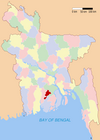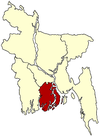Jhalokati Sadar Upazila
Jhalakathi Sadar
ঝালকাঠি সদর | |
|---|---|
Upazila | |
 Jhalakathi Sadar Location in Bangladesh | |
| Coordinates: 22°38.6′N 90°12′E / 22.6433°N 90.200°ECoordinates: 22°38.6′N 90°12′E / 22.6433°N 90.200°E | |
| Country | |
| Division | Barisal Division |
| District | Jhalakati District |
| Area | |
| • Total | 204.48 km2 (78.95 sq mi) |
| Population (1991) | |
| • Total | 195,619 |
| • Density | 960/km2 (2,500/sq mi) |
| Time zone | UTC+6 (BST) |
| Website | Sadar.gif Official Map of the Jhalakati Sadar Upazila |
Jhalakati Sadar (Bengali: ঝালকাঠি সদর) is an upazila of in the Division of Barisal, Bangladesh.[1]
Geography[]
Jhalakathi Sadar is located at 22°38′35″N 90°12′00″E / 22.6431°N 90.2000°E. It has 36,504 households and a total area 204.48 km2. Most of its people are literate.
Demographics[]
According to the 1991 Bangladesh census, Jhalakati Sadar had a population of 195,619. Males comprised 51.13% of the population, and females 48.87%. The population aged 18 or over was 102,890. Jhalakati Sadar had an average literacy rate of 54.4% (7+ years), compared to the national average of 32.4%.[2]
Economy[]
Between 1940 and 1975, Jhalakati was famous for the only automatic rice huller in the region owned by Shudhangshu Bhushan Das Son of Aswini Kumar Das. It was a thriving complex built on an area approximately 2 square kilometer. The smoke from the chimney served as a navigation landmark by passing steamers while the factory siren could be heard from as far as Barisal. After the company declared bankruptcy in 1975 their descendants eventually migrated to India and other parts of Bangladesh. The massive ruins of the factory can still be seen at west Chandkati.
Administration[]
Jhalakati Sadar Upazila is divided into Jhalakati Municipality and 10 union parishads: Basanda, Binoykati, Gabkhandhansiri, Gabharamchandrapur, Keora, Kirtipasha, Nabagram, Nathullabad, Ponabalia, and Sekherhat. The union parishads are subdivided into 158 mauzas and 190 villages.[3]
Jhalakati Municipality is subdivided into 9 wards and 47 mahallas.[3]
Education[]
There are six colleges in the upazila.[3] They include , Hemayet Uddin Degree College, , founded in 1964,[1] , , and Sher-E-Bangla Fazlul Haque College.
According to Banglapedia, Bowkathi Bindu Bashini High School, founded 1918, Jhalokati Government Girls' School (1919), Jhalakathi Government High School (1872), Kirtipasa Prosanna Kumar Secondary School (1903), Nathullabad High School (1923), Udbodhan Secondary School (1940) and Taruli Secondary School (1957) are notable secondary schools.[1]
The madrasa education system includes three fazil and one kamil madrasas.[4] According to Banglapedia, Sarengal Nesaria Honainia Fazil Madrasa, founded in 1974, is a notable Fazil madrasa.[1]
Notable residents[]
- Amir Hossain Amu, Minister of Industries, has been the Member of Parliament for constituency Jhalokati-2 since 2009.[5][6]
- A. K. Fazlul Huq, Prime Minister of Bengal (1937–1943) and Governor of East Pakistan (1956–1958), was born at Saturia in 1873.[7]
- Golam Mustafa, actor[citation needed]
- Kamini Roy, poet and social worker, was born at Basanda village in 1864.[8]
See also[]
- Upazilas of Bangladesh
- Districts of Bangladesh
- Divisions of Bangladesh
References[]
- ^ Jump up to: a b c d Md Mizanur Rahman (2012). "Jhalakathi Sadar Upazila". In Sirajul Islam and Ahmed A. Jamal (ed.). Banglapedia: National Encyclopedia of Bangladesh (Second ed.). Asiatic Society of Bangladesh.
- ^ "Population Census Wing, BBS". Archived from the original on 2005-03-27. Retrieved November 10, 2006.
- ^ Jump up to: a b c "District Statistics 2011: Jhalakathi" (PDF). Bangladesh Bureau of Statistics. Archived from the original (PDF) on 13 November 2014. Retrieved 14 July 2014.
- ^ "List of Institutions". Ministry of Education. Retrieved July 15, 2014.
- ^ "List of 9th Parliament Members". Bangladesh Parliament.
- ^ "Constituency 126_10th_En". Bangladesh Parliament.
- ^ Gandhi, Rajmohan (1986). Eight Lives: A Study of the Hindu-Muslim Encounter. SUNY Press. p. 189. ISBN 0-88706-196-6.
- ^ Kahaly, Anirudha (2012). "Roy, Kamini". In Islam, Sirajul; Jamal, Ahmed A. (eds.). Banglapedia: National Encyclopedia of Bangladesh (Second ed.). Asiatic Society of Bangladesh.
- Upazilas of Jhalakati District


